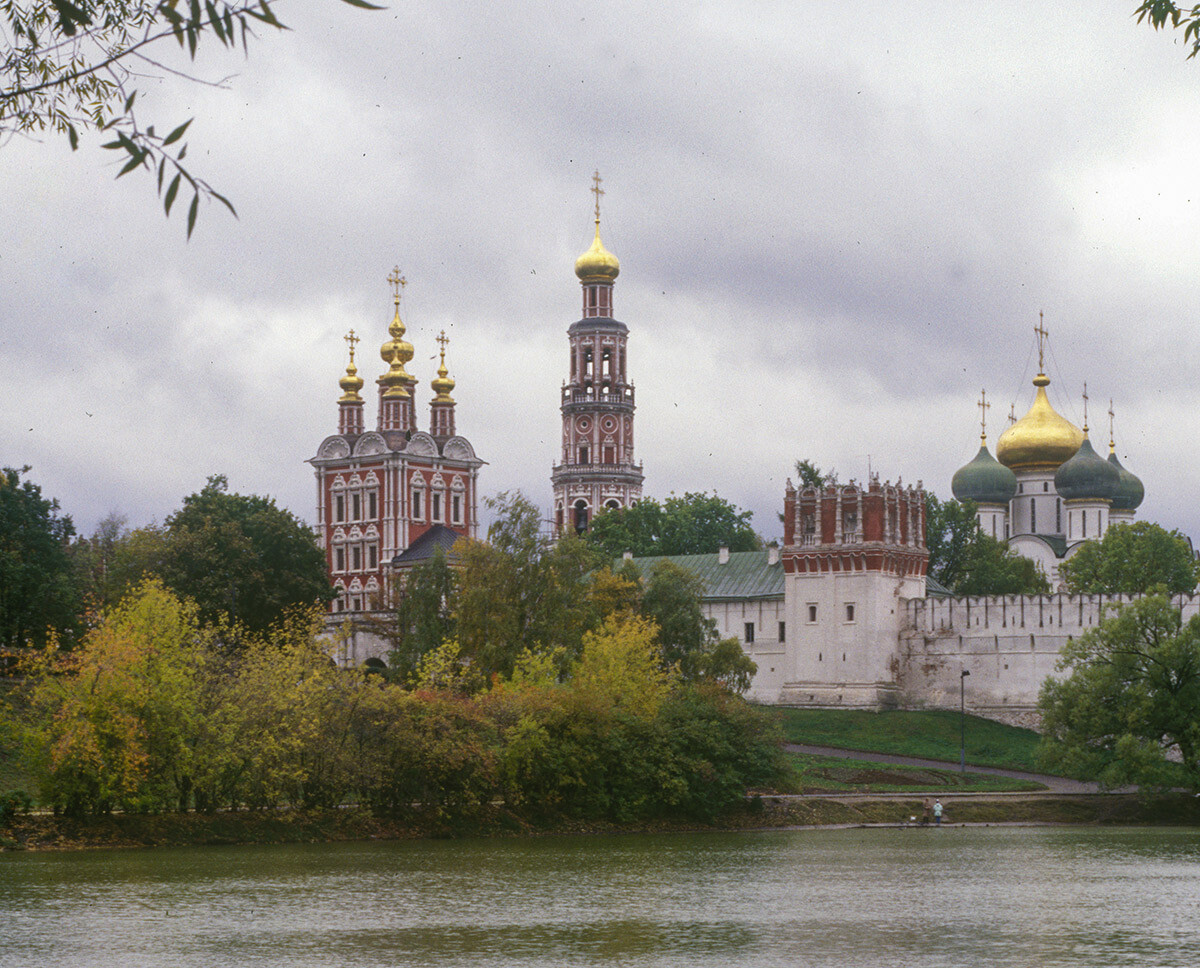
Moscow. Novodevichy (Newmaiden) Convent of the Smolensk Icon. Northwest view across Large Novodevichy Pond. From left: Church of Transfiguration over North Gate; Bell Tower; Lopukhin Tower; Cathedral of Smolensk Icon of the Virgin. October 4, 1997.
William BrumfieldOf all Moscow's monastic institutions, none prospered more openly than the Novodevichy (‘New Maiden’) Convent, whose early 16th-century Cathedral of the Smolensk Icon of the Mother of God served as a prototype – along with the Moscow Kremlin cathedrals – for other major monastery churches in Russia. The name ‘New Maiden’ arose in relation to two older convents in Moscow.

Novodevichy Convent. Cathedral of Smolensk Icon of the Virgin. North view. June 11, 2015.
William BrumfieldThe major event leading to the founding of the convent occurred in 1514, when Muscovite Grand Prince Vasily III (1479-1533; son of Ivan III the Great) took the strategic city of Smolensk, which had been under the control of the Grand Duchy of Lithuania for the preceding century. Ten years later, in 1524, Vasily III fulfilled his vow to establish the convent in commemoration of the incorporation of Smolensk within the Muscovite state. Thus, the Novodevichy Convent has now existed for half a millennium.
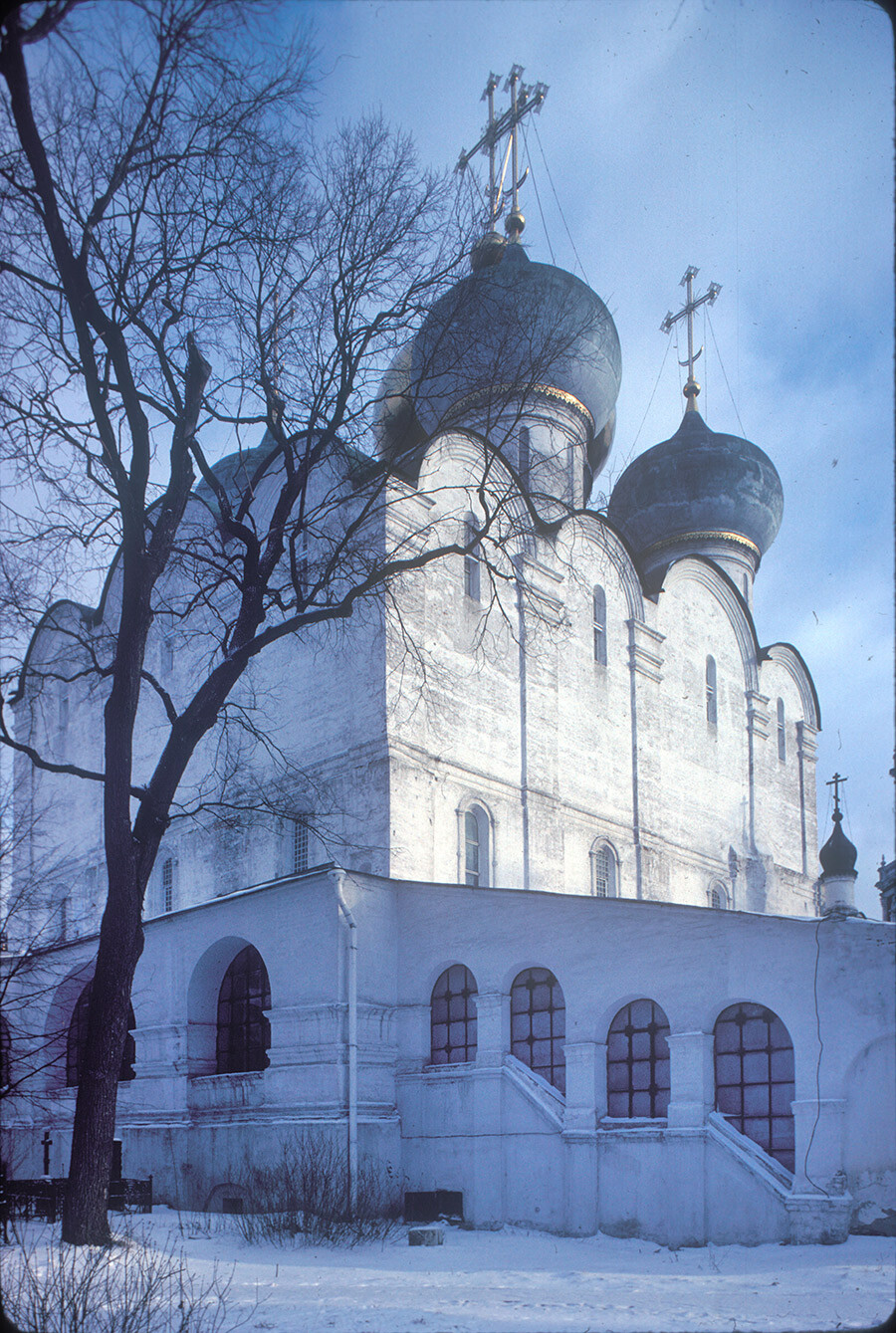
Cathedral of Smolensk Icon. Southwest view with enclosed entrance stairway. December 17, 1983.
William BrumfieldThe convent's main shrine was dedicated to one of the most revered Orthodox icons, the Smolensk Icon of the Mother of God, or ‘Hodegetria’. Traditional narratives state that the icon was among those painted by St. Luke and it defined the iconic form ‘Hodegetria’ (from the Greek for “She who points the way”), in which Mary holds the Christ Child on her left arm and points to the infant with her right hand.Through imperial patronage, the image made its way from Jerusalem to the Blachernae Church of St. Mary in Constantinople under the protection of Empress Pulcheria (398-453), canonized by both the Catholic and Orthodox Churches for her role in consolidating early Christianity.
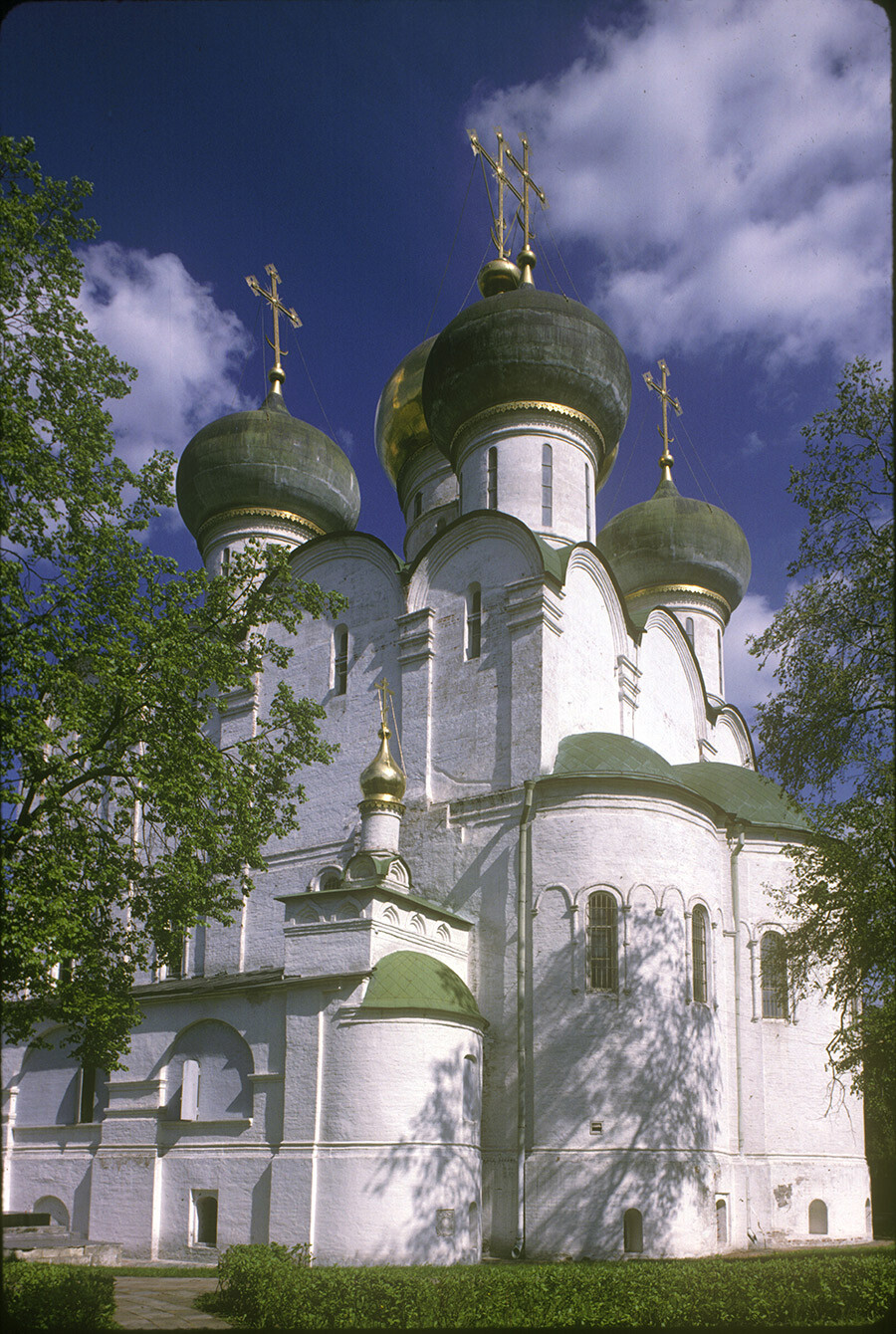
Cathedral of Smolensk Icon. Southeast view with attached chapel of Miracle of Archangel Michael at Chonae. May 13, 1995.
William BrumfieldAccording to church accounts, Byzantine Emperor Constantine IX Monomachos gave the ‘Hodegetria’ Icon to his daughter Anastasia (or Anna; the precise name is unclear) in the year 1046 on the occasion of her marriage to Vsevolod, son of Kievan Grand Prince Yaroslav the Wise.
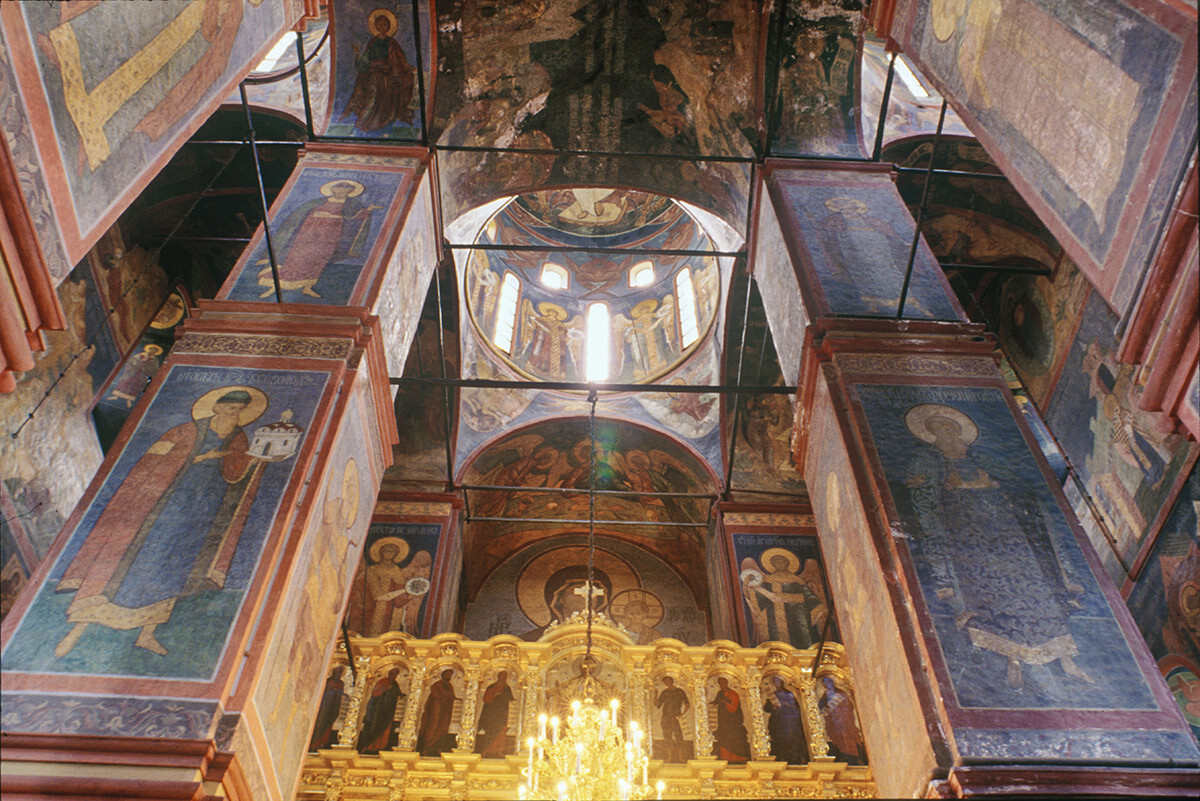
Cathedral of Smolensk Icon. Interior, view east toward icon screen & main dome. Left: north central pier with fresco of Grand Prince Vsevolod III holding model of Dormition Cathedral in Vladimir. May 25, 1997.
William BrumfieldAfter Vsevolod’s death, the icon was inherited by his son Vladimir II Monomakh (1053-1125; the Byzantine name inherited from his mother), who played an enormous role in expanding the power and territory of medieval Rus’. Around 1095, Vladimir transferred the icon from Chernigov, his original principality, to Smolensk, where, in 1101, he initiated the construction of the original Cathedral of the Dormition of the Mother of God. The icon was eventually installed inside the cathedral, which was completed in the 1140s by Monomakh’s grandson, Rostislav Mstislavich (1110-1167), who ruled in Smolensk from 1125 until 1160. In 1239, the cathedral and the icon survived the Mongol invasion, which had little impact on Smolensk itself.

Cathedral of Smolensk Icon. Interior, ceiling of south aisle & southwest dome with fresco of John the Baptist, Angel in the Wilderness. Left: central aisle. May 25, 1997.
William BrumfieldIn 1398, the icon was brought to the Russian capital by Princess Sophia, bride of Grand Prince Vasily I, son of Dmitry Donskoi. The icon remained in the Moscow Kremlin’s Annunciation Cathedral until 1456, when at the request of the bishop of Smolensk, the Hodegetria Icon was returned by Grand Prince Vasily II. Before its return to Smolensk, a faithful copy of the icon at the same size was made for Kremlin Annunciation Cathedral, where it stayed until 1525, when it was transferred to Novodevichy Convent and eventually placed in the Cathedral of the Smolensk Icon, completed around the mid 16th century.
Unlike most medieval Russian monastic institutions, which grew gradually from modest log structures to imposing masonry structures as resources and donations permitted, the development of the Novodevichy Convent began with major princely patronage and the rapid construction in brick of a large central church (‘sobor’) that rivaled the main shrines of the Moscow Kremlin itself.
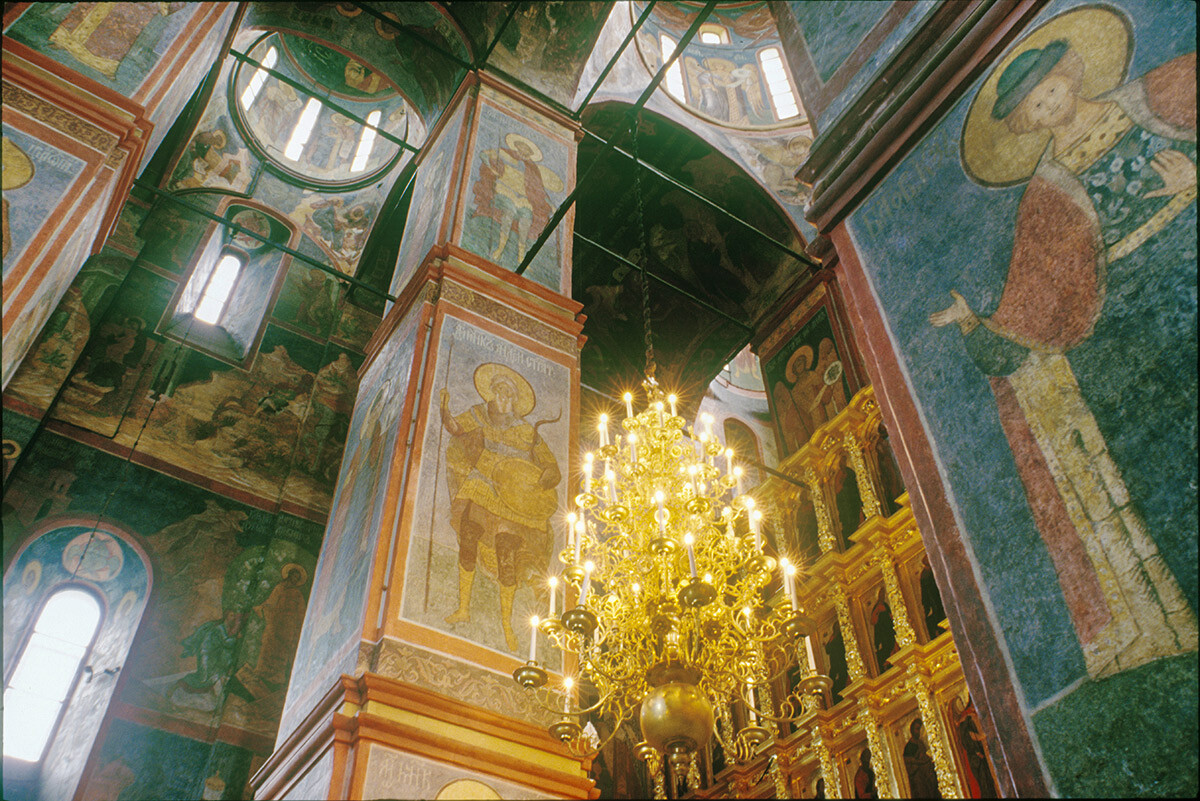
Cathedral of Smolensk Icon. Interior, view northeast toward icon screen. Right: south center pier with fresco of Saint Gleb. May 25, 1997.
William BrumfieldThis resemblance was no accident. From the 1470s to the beginning of the 15th century, the Dormition and Archangel Michael Cathedrals in the Moscow Kremlin were rebuilt by Italian architects Aristotle Fioravanti and Aleviz Novy. Thoroughly knowledgeable in the engineering requirements for large structures, these architects reintroduced the form of five cupolas over an elongated variant of the cross-inscribed plan, a practice largely neglected since the 12th century in Suzdalia. This distinctive arrangement of cupolas over drums subsequently became an obligatory feature of imposing churches built in the style of the Kremlin Dormition Cathedral.
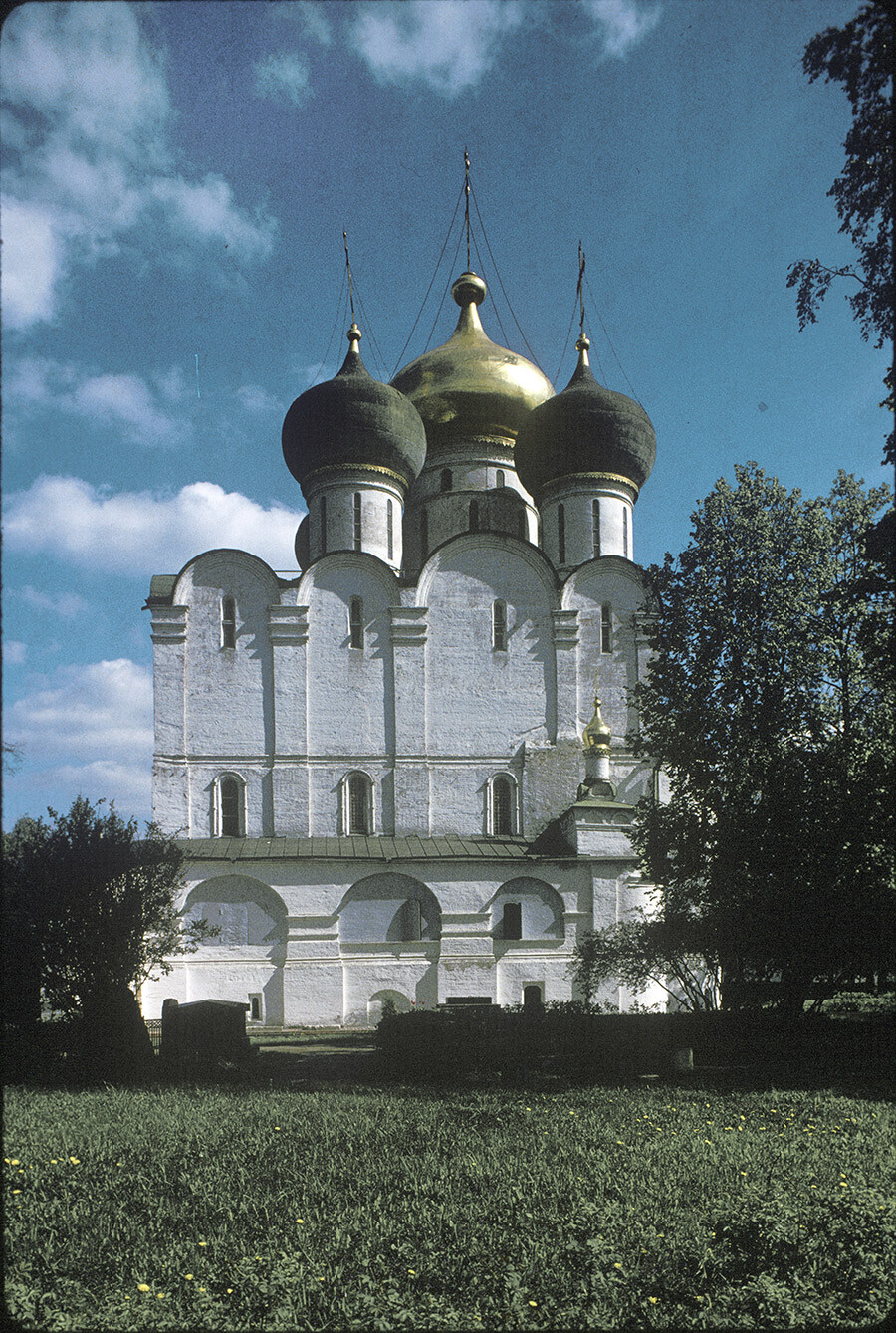
Cathedral of Smolensk Icon. South view with attached chapel of Miracle of Archangel Michael at Chonae. Photo: William Brumfield. May 13, 1995.
William BrumfieldDuring this period, the dedication of new monumental churches moved toward symbolic commentary on major events occurring within the reign of the grand prince. For example, the Cathedral of the Smolensk Icon of the Mother of God at Moscow's Novodevichy Convent commemorated the bringing of the strategic city of Smolensk into the Russian state. In contrast to the Kremlin Dormition Cathedral, the main curved gable (‘zakomara’) of each facade of the Smolensk Cathedral is distinguished by greater height and width, thus reflecting the arms of the inscribed cross on the interior.
The verticality is further developed by building the church above a ground floor or ‘podklet’. As in other churches of similar design – such as the Transfiguration Cathedral in Yaroslavl – the ‘podklet’ served as a burial chamber for wealthy nobles or members of the princely family. The cathedral culminates in five massed domes, of which the gilded central dome soars above the four located on the corners. Their peaks support ornamented, gilded crosses whose height complements the proportions of the drums and cupolas.
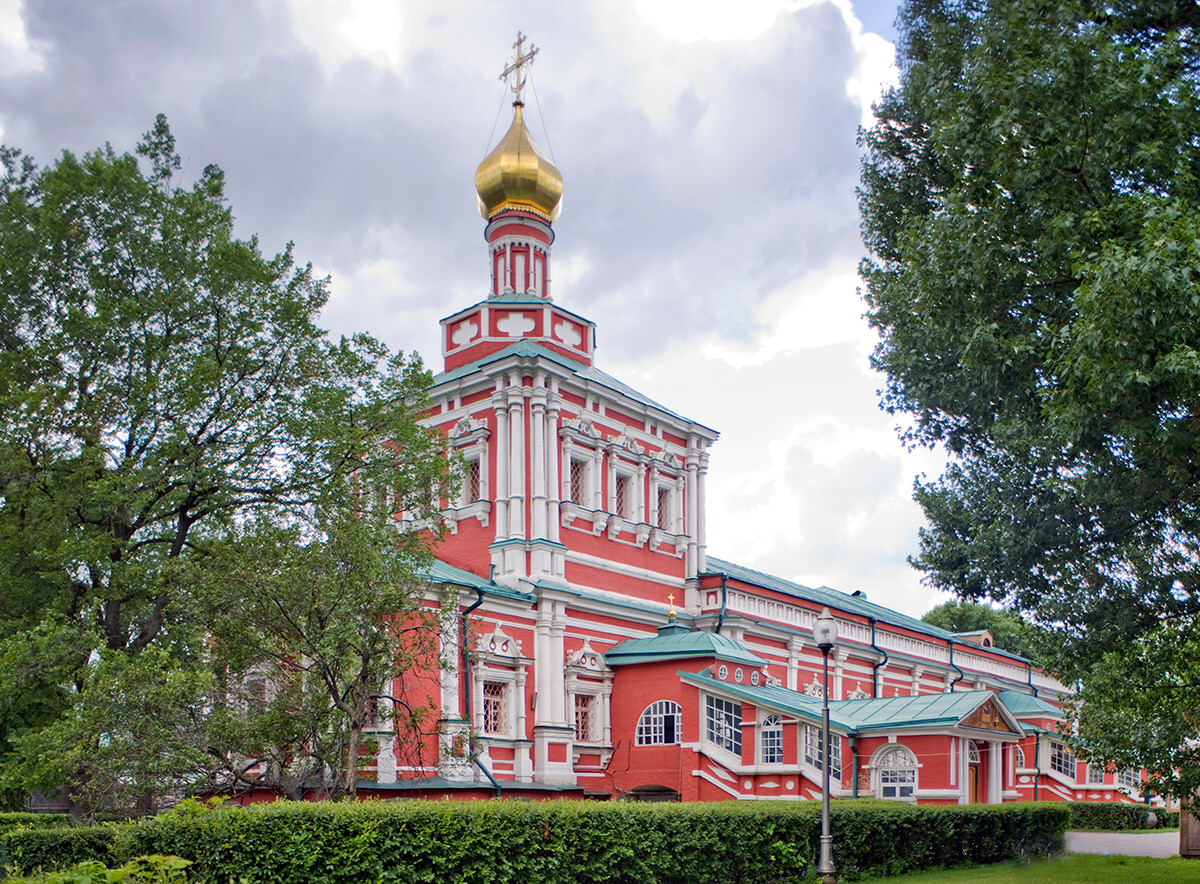
Novodevichy Convent. Refectory Church of the Dormition, northeast view. Photo: William Brumfield. June 11, 2015.
William BrumfieldThe implicit dedication of this impressive structure to a political event – and, more specifically, a military victory – confirms a tendency toward merging secular and religious symbolism in 16th-century Muscovy. The Kremlin churches, like the rebuilt cathedrals of Rostov and Suzdal, had existed in previous form before the expansion of the Muscovite state, but the rebuilding of these ancient cathedrals also expressed the ascent of Moscow's political power. Whatever the original dedication, the proliferation of major churches in imitation of the Kremlin Dormition Cathedral not only symbolized Muscow's gathering of the Russian lands, but also in a tangible sense recreated the sanctum of Moscow at strategic locations throughout its expanding territory.
At the end of the 16th century, the convent received donations from Irina Godunov and her brother Tsar Boris Godunov, whose election as tsar occurred within its walls in 1598. Godunov made major donations to the convent and undertook the rebuilding and expansion of its walls (The walled convent played a role in the repulse of Crimean Khan Kazy Girei in 1591). The elaborate crowns of the wall towers were added in the late 17th century.
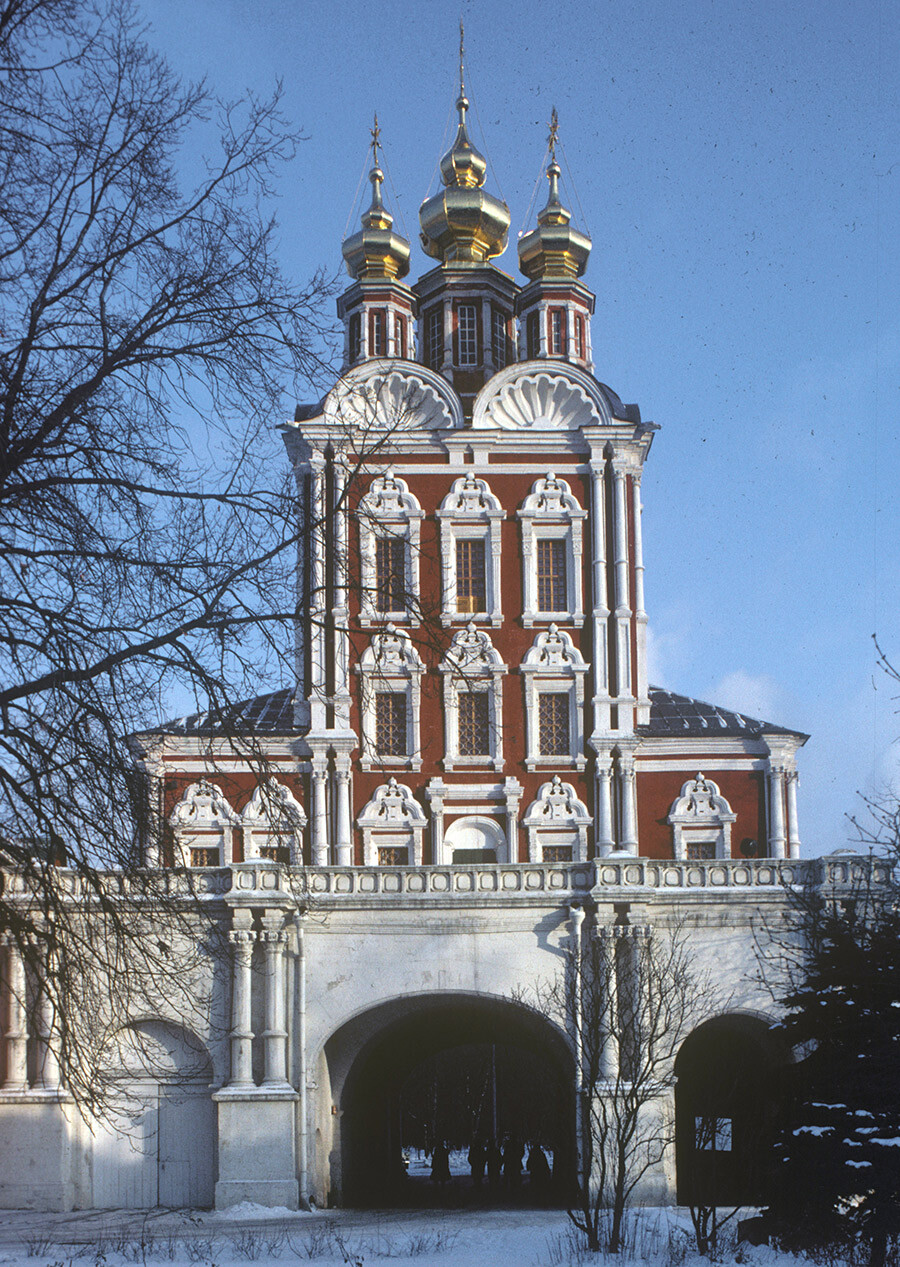
Novodevichy Convent. Church of the Transfiguration over North Gate. South view. December 17, 1983.
William BrumfieldThe major building campaign at the convent was supported by Tsarevna Sophia during the years of her regency (1682-1689). She was assisted in this endeavor by her main advisor Prince Vasilii Golitsyn, an architectural innovator much interested in western forms. The palatial, secular orientation of the style is reflected in the refectory Church of the Dormition (1685-1687) and the Church of the Transfiguration over the north gate (1687-1689), whose gilded five domes and crosses crown a cornice of scallop shell ‘zakomary’. This festive decoration is echoed on the facades with elaborate ‘Moscow Baroque’ window surrounds. The south gate Church of the Intercession (1683-1688) is more modest in detail, but has the unusual design of three towers of ascending octagons with gilded cupolas. Both gate churches have terraces over the gates and at the base of the church proper, thus creating a platform for the jeweled structure above.

Novodevichy Convent. Church of the intercession over South Gate. South view. Left: Maria Chambers (Marinsky Palaty). June 11, 2015.
William BrumfieldThe culminating element of Novodevichy Convent's expansion was the great bell tower, finished in 1690 and one of the tallest in Russia at that time – 72 meters, as compared with 81 meters for the Bell Tower of Ivan the Great in the Moscow Kremlin. The tower of receding octagons displays great technical ingenuity, as well as the decorative exuberance of the Moscow Baroque. Its balustrades and pinnacles at the base of each octagon remind of the Tolchkovo bell tower in Yaroslavl, yet the finely calculated proportions of the Novodevichy tower are more spacious and the onion dome provides a dramatic, luminescent concluding accent. By the time the bell tower was completed, the power of the convent's benefactress Sophia had been broken by Peter I against an unsuccessful coup attempt of 1689, after which Sophia was confined to the Novodevichy Convent. With Peter's transfer of the capital to St. Petersburg in the early 18th century, the convent's political connections were further diminished. And, in 1764, it lost much of its extensive land holdings as a result of the secularizing monastic reforms in the early part of Catherine the Great's reign.

Novodevichy Convent. Bell tower with Church of St. John and Church of Sts. Barlaam & Josephat. West view. March 8, 1972.
William BrumfieldThe convent witnessed numerous military actions, such as assaults on Moscow by Crimean Tatars in 1571 and 1591, as well as frequent clashes between Russian, Polish and Cossack forces between 1606 and 1612 during the so-called ‘Time of Troubles’. With the failure of their occupation of Moscow, French forces unsuccessfully attempted to blow up the convent's Smolensk Cathedral. During the Soviet period, the convent was converted to a series of museums and remained relatively unscathed. Limited religious use began in 1943 and, in 2010, the convent was returned to the Russian Orthodox Church.
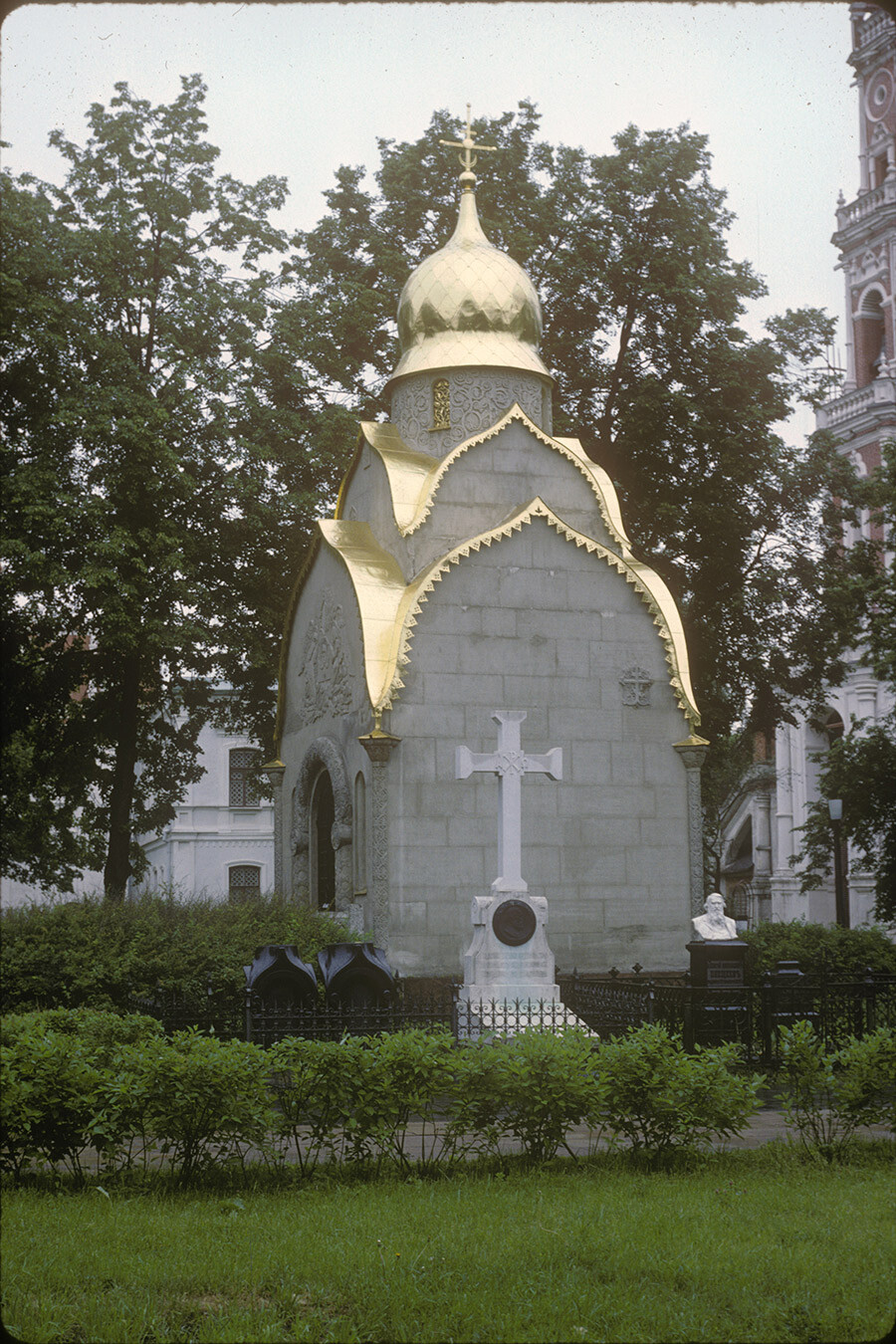
Novodevichy Convent. Prokhorov burial chapel. Foreground: grave of Sergey Solovyov. June 7, 1993.
William BrumfieldIn addition to its churches and cloisters, the convent also has a remarkable necropolis, which contains the graves of many prominent historical personages, such as poet and military hero Denis Davydov, historians Mikhail Pogodin and Sergei Solovyev, as well as the latter's son Vladimir Solovyov, a noted philosopher and a poet. Also buried are the remains of Anton Chekhov, composer Alexander Scriabin and General Aleksey Brusilov, along with prominent entrepreneurs such as the Prokhorovs, who created an exquisite mausoleum in the art nouveau style.
William Brumfield is the author and photographer of the stunning volume ‘Journeys through the Russian Empire’, available on Amazon.
If using any of Russia Beyond's content, partly or in full, always provide an active hyperlink to the original material.
Subscribe
to our newsletter!
Get the week's best stories straight to your inbox